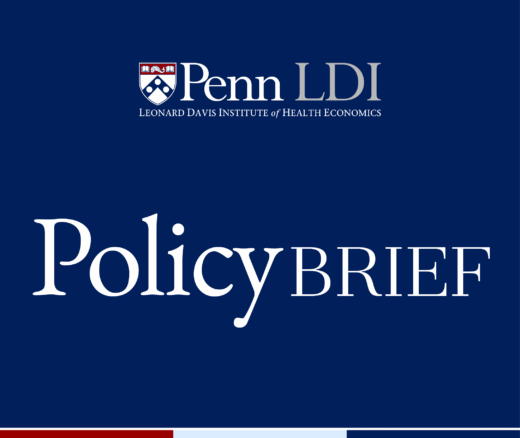
New APHA Book Warns Social Systems Are Driving Deepening Health Inequities
Penn LDI’s Antonia Villarruel and 10 Other Authors Map Social Determinants Across Multiple Racial and Ethnic Groups
Population Health
News
The only study to evaluate the association of hospital nurse staffing level variations and patients’ odds of dying during the COVID-19 emergency concluded that many deaths among patients hospitalized for COVID-19 could have been prevented if hospitals entered the pandemic with adequate numbers of registered nurses (RNs), a workforce rich in Bachelor of Science degree qualified RNs, and high-quality nurse work environments.
Titled “Hospital Nursing Staffing Variation and COVID-19 Deaths: A Cross-Sectional Study,” the paper was co-authored by LDI Senior Fellows and University of Pennsylvania School of Nursing faculty members Karen B. Lasater, PhD, RN; Matthew D. McHugh, PhD, RN; and Linda H. Aiken, PhD, RN.

Published in the International Journal of Nursing Studies, the work adds to a large body of evidence generally associating nurse staffing variations to trends in patient outcomes and deaths at the same time it underscores elements of the national debate about the overall adequacy of hospital emergency preparedness during the pandemic as well as for the next major national health emergency.
“Many hospitals were chronically understaffed prior to the pandemic, and on average, we found that staffing levels did not meaningfully improve during the pandemic to meet the accelerating care needs of very sick and medically complex patients,” said lead author Lasater.
The study pointed out that during the pandemic, COVID-19 mortality varied depending on the hospital where patients were admitted, but it was unknown what aspects of the hospitals’ operations were important for mitigating preventable deaths.
The study objective was to “determine whether hospital differences in pre-pandemic and during pandemic nursing resources—average patient-to-registered nurse (RN) staffing ratios, proportion of bachelor-qualified RNs, nurse work environments, Magnet recognition—explain differences in risk-adjusted COVID-19 mortality; and to estimate how many deaths may have been prevented if nurses were better resourced prior to and during the pandemic.”
The term “Magnet recognition” refers to certification by the American Nurses Association’s (ANA) American Nurses Credentialing Center (ANCC) that a hospital follows an evidence-based standard for transformational nursing leadership, empowerment of front-line nurses, evidenced-based professional nursing practice, and high-quality care, known to minimize clinician stress and improve patient care.
The investigation evaluated data from 237 hospitals and more than 87,000 older adult patients admitted with COVID-19 during the height of the pandemic and found that “variation in hospital nursing resources prior to the COVID-19 pandemic is associated with many thousands of preventable COVID-19 deaths during the pandemic.”
One study finding that directly relates to the outlook for current and future hospital emergency preparedness was that “Hospital nursing resources are often overlooked in conversations about lessons from the U.S. COVID-19 response and hospitals have not yet been able to recover from the effects of COVID-19 as they continue to experience difficulties recruiting and retaining nurses after the official end of the pandemic.”
And as further context for the issue, the study points back to multiple previous works that looked at nursing during the pandemic and found “serious misalignments” between the resources nurses were provided with and what they actually needed to optimize patient care. One of those earlier studies found that the most important resources nurses said they needed in order to provide safe and quality care during and after the COVID-19 emergency were flexible work scheduling and adequate staffing. But more than two-thirds of nurses surveyed reported these resources were not provided to them by their hospitals.
A currently related controversy suggests that insufficient RN staffing is associated with the lack of sufficient registered nurses available in the U.S. But Lasater pointed to a just-released national analysis by Marsh McLennan’s Mercer, a human resources and financial services consulting firm. It reports that, “At a national level, the supply of RNs is projected to outpace demand, resulting in an estimated surplus of nearly 30,000 RNs by 2028.”
In previous papers, Lasater has explained that the current insufficient numbers of nurses in hospitals is not a function of overall supply but rather poor working conditions in hospitals that drive high clinician burnout, job dissatisfaction, turnover, and poor patient outcomes. Other recent evidence documents the continued growth in the number of newly licensed nurses but notes a shift in employment away from hospital settings toward ambulatory and community settings.
The American Nurses Association (ANA) endorses safe staffing ratios that would require hospitals to meet a minimum standard level of nursing care. Meanwhile, California and Oregon have already established enforceable staffing ratio requirements. As a result, patients hospitalized in California receive an average of three more hours of RN care per day compared to patients in other states. Oregon implemented their ratio policy in the summer of 2024.
Other U.S. jurisdictions including Pennsylvania, Maine, Georgia, Illinois, and New Jersey have all introduced safe staffing bills. Elsewhere in the world, a prospective evaluation of staffing ratios in Queensland Australia showed the introduction of staffing legislation in hospitals resulted in better staffing ratios, lower mortality, fewer readmissions, and shorter stay durations for patients.
When asked what policymakers can take away from her new study findings, Lasater said, “Federal and state policies that address the underlying issue of chronic nurse understaffing requires action today. If having enough nurses to care for the public and prevent avoidable deaths during future public health emergencies is a national priority, action is needed to prevent chronic understaffing of nurses during normal times.”

Penn LDI’s Antonia Villarruel and 10 Other Authors Map Social Determinants Across Multiple Racial and Ethnic Groups

Memo: Response to Request for Analysis

Lessons from the Past, Imperatives for the Future

A New Study of a Sample of Facilities Found Half Without Any Behavioral Health Staff

Physicians Were Paid About 10% Less for Visits Involving Black and Hispanic Patients, With Pediatric Gaps Reaching 15%, According to a First-of-Its-Kind LDI Analysis

A New Review Finds Hospital Mergers Raise Prices Without Improving Care, and Urges Regulators to Stop Accepting Quality Claims to Justify Consolidations